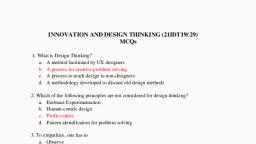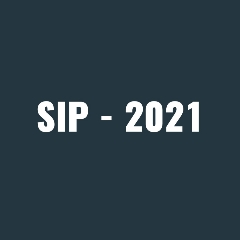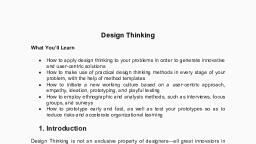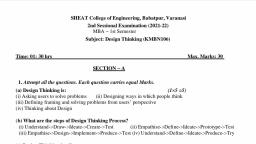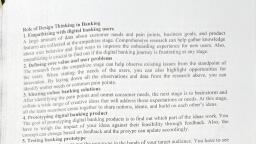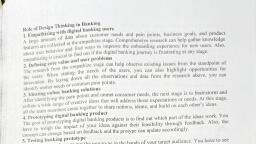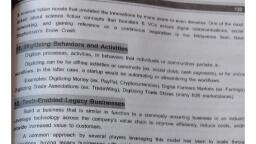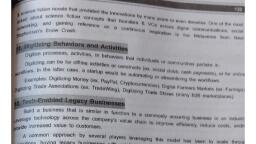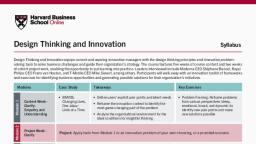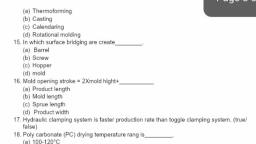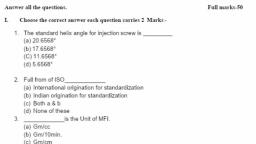Page 1 :
INNOVATION AND DESIGN THINKING (21IDT19/ 29), MCQs, 1. What is Design Thinking?, a. A method facilitated by UX designers, b. A process for creative problem solving, c. A process to teach design to non-designers, d. A methodology developed to discard old design methods, 2. Which of the following principles are not considered for design thinking?, a. Embrace Experimentation, b. Human-centric design, c. Profit-centric, d. Pattern identification for problem solving, 3. To empathize, one has to, a. Observe, b. Engage, c. Listen, d. All of the above, 4.Which of the following are NOT tools of visualization?, a. Maps, b. Images, c. Stories, d. Videos, 5._____________ storytelling is the most compelling type of story, a. Aural, b. Visual, c. Textual, d. All of the above, 6. What happens in the test stage of design thinking?, a. You conduct a written test of your design team., b. You allow consumers to test a product or service., c. You engage in internal testing with employees., d. You test products designed by competitors., 7. Collecting _____ is an important portion of testing a prototype in the test stage of design, thinking., a. Pictures, b. Money, c. Feedback, d. Emails
Page 2 :
8. Mind maps are used to ________ideas, a. Generate, b. Visualize, c. Structure, d. All of the above, 9. Journey mapping is also called _________ mapping, a., b., c., d., , Path, Experience, Conduct, Feedback, , 10. Which of the following are NOT tools of Design Thinking?, a., b., c., d., , Co-creation, Prototyping, Mind Mapping, Online Marketing, , 11. Which of these are NOT components of a mind map?, a., b., c., d., , Branches, Arrows, Central Idea, All of the above are components, , 12. Journey mapping maps which phase of activity of service for a customer?, a., b., c., d., , Before a service, During a service, After a service, All of the above, , 13._______________is used with the objective of identifying needs that customers are often, unable to articulate., a., b., c., d., , Mind mapping, Experience mapping, Story telling, Rapid Concept Development, , 14. Value chain analysis examines how an organization interacts with value chain partners, to ________________ new offerings., a., b., c., d., , Produce, Market, Distribute, All of the above
Page 3 :
15. A prototype is a simple experimental model of a proposed solution used to, a., b., c., d., , test ideas, validate ideas, Both, None of the above, , 16. A hypothesis is ______., a. a wished-for result that the researcher concludes the research with, b. a complicated set of sentences that pulls variables into proposed complex, relationships, c. a conjecture that is grounded in support background originating from secondary, research, d. None of the above, 17. Learning launches are designed to test the key underlying value-generating assumptions, of a potential new-growth initiative in the marketplace., a. True, b. False, c. Cannot be said, 18. What is your first model/design of a product called?, a. Draft, b. Rough Draft, c. Prototype, d. Practice Design, 19. To Ideate is, a. To rapidly change., b. When you create a 3D model of your design., c. The process for creating and sharing ideas where you use images and sketches, instead of words to describe your idea., d. When you brainstorm ideas, get feedback, create an initial design, share the design,, and iterate., 20. In design, where does the information used to put together a problem statement come, from?, a., b., c., d., , The Design Stage, The Ideate Stage, The Define Stage, The Testing Stage, , 21. A case study is, a. a research strategy, b. an empirical inquiry
Page 4 :
c. a descriptive and exploratory analysis, d. All of the above, 22. Which is NOT a good interview strategy for the Empathy step?, a., b., c., d., , Encourage the person to talk about experiences., Encourage short answers that get right to the point., Ask follow-up questions to get more information., Try to uncover needs people may or may not be aware of., , 23. Which is NOT an aspect of the Define step of design thinking?, a., b., c., d., , Create a composite user to give perspective to the solution, Develop a Point of View statement to state user's need, Define as many possible solutions to the problem as possible, Recognise a challenge with a "How Might We" question, , 24. ___________ is an analysis of persons, groups, events, decisions, periods, policies,, institutions or other systems that are studied holistically by one or more methods., a., b., c., d., , Literature Study, Case Study, Co-creation, Prototyping, , 25. MVP stands for, a., b., c., d., , Minimum viable product, Maximum viable product, Most viable product, None of above, , 26. At what step do you want to complete the POV - point of view?, a., b., c., d., , empathy, prototype, define, ideate, , 27. Design thinking principles DO NOT include, a., b., c., d., , Feasibility, Viability, Desirability, Credibility, , 28. The final step in the Design Process is to ____., a. Test, b. Define, c. Ideate
Page 5 :
d. Empathize, , 29. The purpose of MVP is NOT, a., b., c., d., , Be able to test a product hypothesis with maximum resources, Accelerate learning, Reduce wasted engineering hours, Get the product to early customers as soon as possible, , 30. The three “I”s of Design thinking DO NOT include, a., b., c., d., , Interest, Implementation, Inspiration, Ideation, , 31. Rashmi is creating a new product for Architectural college students. She takes a designthinking approach. Her first step is, addressing who she is creating the product for? and, conducts research on understanding this target market. What is this step in the design, thinking process?, a., b., c., d., , Define, Ideate, Empathise, Prototype, , 32. Collaborative teamwork is essential in design thinking for, a., b., c., d., , Equal Importance to all members, Solving multifaceted problems, Unbiased Selection of ideas, Better failure management, , 33. Design Thinking is best suited to addressing problems at the intersection of, a., b., c., d., , business and society, logic and emotion, human needs and economic demands, All of the above, , 34. Frank Robinson defined and coined the term, a., b., c., d., , Design Thinking, Mind Mapping, MVP, Hypothesis, , 35. Design Thinking process began with the following 3 steps:
Page 6 :
a., b., c., d., , Understand - Improve – Apply, Define – Ideate – Build, Study – Solve – Create, Understand – Ideate – Create, , 36. User persons are created during which phase of design process, a., b., c., d., , Design stage, Discover stage, Develop stage, None of the above, , 37. ____________ was IDEO'S first expression of design thinking., a., b., c., d., , Deep-Design, Deep-Dive, Deep-Structure, Study-Dive, , 38. ___________ Helps the design team and client to visualize and handle the design, concept, a., b., c., d., , Define, Ideate, Empathise, Prototype, , 39. Human-centric design was re-interpreted as an acronym to mean, a., b., c., d., , Hear, Create, Deliver, Hear, Create, Design, Hold, Create, Deliver, Hear, Compile, Deliver, , 40. The ultimate goal of design thinking is to help you design better, a., b., c., d., , Services, Products, Experiences, All of the above, , 41. Design thinking typically is a, a., b., c., d., , Non-linear process, Linear process, Cyclic process, None of the above, , 42. In the Create phase we DO NOT
Page 7 :
a., b., c., d., , Recognise existing knowledge in the challenge space, Recruit participants for the co-design task from a diverse pool of those affected, Maintain awareness of sensitivities by avoiding judgements, Encouraging storytelling and expression, , 43. Design thinking has, a., b., c., d., , Nothing to do with graphic design, Nothing to do with architectural design, Very little to do with UI and UX design, Everything to do with products that succeed., , 44. …………… is the way to narrow down the thoughts to reach at the final solution, a., b., c., d., , Convergent thinking, Divergent thinking, None of them, Both of them, , 45. Design thinking is also known as, a., b., c., d., , Adaptable Enquiry, Strategic design thinking, Transformation by design, All of the above, , 46. Design thinking follows, a., b., c., d., , Waterfall Model, Agile methodology, Both of these, None of these, , 47. The goal of the prototype phase is, a., b., c., d., , To understand what component of your idea didn't work, To understand what component of your idea worked, Both of them, None of them, , 48. BPM stands for, a., b., c., d., , Building Product Management, Business Product Management, Business Process Management, Basic Product Management, , 49. ___________ is an iterative and incremental method of managing development and, design.
Page 8 :
a., b., c., d., , Waterfall Model, Agile Methodology, Cyclic Methodology, All of the above, , 50. Which of the following sequences in correct for Waterfall Methodology?, a., b., c., d., , Define – Design – Develop – Test - Deploy, Define – Develop – Design - Test - Deploy, Define – Design – Develop – Deploy – Test, Design - Define – Develop – Test - Deploy, , 51. The final step in the Design Process is to ____., a) Test, b) Define, c) Ideate, d) Empathize, 52. During which stage would you consult experts to learn more about the areas of concern, and to gain an understanding of other people's experiences?, e) Prototype, f) Define, g) Ideate, h) Empathize, 53. During which stage would you gather information about people's needs and motivations?, i) Prototype, j) Define, k) Ideate, l) Empathize, 54. The first step in the Design Process is to ____., m) Test, n) Define, o) Ideate, p) Empathize, 55. You would interview people to gain an understanding of how they feel during the ____, stage of Design Thinking., q) Test, r) Define, s) Ideate, t) Empathize, 56. Design Thinking is:, a) Thinking about design, b) Designing ways in which people think
Page 9 :
c) Asking users to solve problems, d) Defining, framing and solving problems from users' perspectives, 57. What are the steps of Design Thinking Process?, a. Understand > Draw > Ideate > Create > Test, b. Empathise > Define > Ideate > Prototype > Test, c. Empathise > Design > Implement > Produce > Test, d. Understand > Define > Ideate > Produce > Try, 58. Which of the below firm is associated the most with Design Thinking?, a., b., c., d., , Ikea, Ideo, Idea, Ikei, , 59. Design thinking typically helps in _______, a., b., c., d., , Innovation, Data analytics, Financial planning, Operational efficiency, , 60. Which of the below is incorrect?, a., b., c., d., , PepsiCo has turned Design Thinking into its strategy, Air BnB avoided bankruptcy and turned profitable using Design Thinking, Google has a 3 step process to bring about new innovations, All of the above are correct, , 61. Design thinking is a linear process?, a. True, b. False, 62. Which of the following is not one of the profiles of design thinkers?, a., b., c., d., e., , Empathy, Simplicity, Integrative thinking, Optimism, Experimentalism, , 63. Majority of the top executives regarded ………… as one of the top 3 leadership, qualities?, b), c), d), e), , a. Empathy, Creativity, Humility, Qualifications, Experience, , 64. Which of the following is right?
Page 10 :
a. Design sensibilities are a combination of design features, qualities and, aesthetics., b. Empathy is to see no evil, hear no evil and speak no evil., c. Design sensibilities are complex feelings such as amenity, pleasantness,, comfort, pleasure, etc., d. Empathy is seeing with your own eye, hearing with your own ear and feeling, the pain with your own heart., e. a & d, 65. Identify the correct statement, a. To derive the power of design thinking, individuals, teams, and, organizations must have a leap of faith about the existence of a solution., b. Leap of faith is the page in the manual of design thinking containing, the core philosophy about design thinking., c. Design thinking presupposes that some people are inherently creative and, become successful in creative product development. The team should have, at least one such person., d. None of the above., 66. Which of the following statements is correct?, a. Design thinking is convergence-divergence process, b. Design thinking is a linear process of product development that compulsorily, involves validation at the end of the product development., c. Design thinking is regarded as a lean start-up process., d. Design thinking is predominantly a product development process and is, not very suitable for service innovation., e. Design thinking follows the agile process of product development., 67. A college is redesigning its website. Current students are the main users of the, website. Which one of the below elements should definitely be on the website?, a., b., c., d., , College rules and regulations, Information on faculty members, Information about courses, Alumni details, , 68. What is wrong with this product design?
Page 11 :
a), b), c), d), , The colour is too bright., It does not function as a chair should., It will not be comfortable for the user., The design is too unstable., , 69. What step of the design process did they miss?, , a), b), c), d), , Manufacturing, Research, Prototyping & Testing, Design Brief, , 70. What question did the designers forget to ask?, , a. How many urinals are needed?, b. How much space is needed per person?, c. What will the toilet look like once the floor plan is complete?, d. Where do they go?, 71. At what step do you want to complete the POV - point of view?, a. empathy, b. prototype, c. define, d. ideate, 72. Prototype should only be demonstrated and tested within the team
Page 12 :
a. True, b. False, 73. The initial design brief is provided by, a. Designer, b. User, c. Both of them, d. Client, e. None of them, 74. When defining a problem, your problem statement should include a solution., a. True, b. False, 75. True or false, design thinking can be applied in other professions?, a. True, b. False, 76. Is 'prototyping' a step in the design-thinking process?, a. true, b. false, 77. What element of User Experience Design would the design strategy fall under?, a. Interaction Design, b. Experience Strategy, c. User Research, d. Information Architecture, 78. Taking into account the look and feel of a product and its presentation is userexperience design?, a. True, b. False, 79. No alterations are to be made in the design after testing phase, a. True, b. False, 80. What helps the design team and client to visualize and handle the design concept, a. Define, b. Ideate, c. Empathise, d. Prototype, 81. Design brief given by the client be modified or re-written?, a. True, b. False, 82. The ultimate goal of design thinking is to help you design better, a. Services, b. Products, c. Experiences
Page 13 :
d. All of above, 83. Design thinking typically provides a solution based to problem solving, a. True, b. False, 84. in the delivery phase we, a. Iterate, b. Test, c. Prototype, d. All of above, 85. Empathy is crucial because it allows design thinkers to set aside their assumptions, about the world to gain insight into users and their needs., a. True, b. False, 86. What is the key in any design thinking process?, a. Empathy, b. Defining the problem, c. Designing the solution, d. None of these, 87. The goal of the prototype phase is?, a. To understand what component of your idea didn't work, b. To understand what component of your idea work, c. Both of them, d. None of them, 88. The winning design is typically that which most closely meets the design brief and, need not necessarily adhere to budget and timeline, a. True, b. False, 89. A sitemap is a high-level diagram portraying the general structure and architecture, of the website., a. True, b. False, 90. MVP stands for, a. Most viable product, b. Maximum viable product, c. Minimum viable product, d. None of above, 91. Being an experimental phase, continuous iterations can take place here, which, phase it refers to?, a. Define, b. Empathise, c. Prototype, d. None of them
Page 14 :
92. Design Thinking is a _____., a. Way of thinking about design, b. Method and mindset to define, frame, and solve problems, c. Way to separate “thinking” from “making”, d. Curriculum for teaching non-designers design, 93. One term for observing and interviewing users where they live/work/play for the sake, of design research is:, a. Human factors, b. Contextual inquiry, c. Intercept interview, d. Style scouting, 94. The technique and mindset of “Yes, and” is borrowed from:, a. Wedding planners, b. Lawyers, c. Improvisational theatre, d. Architecture, 95. Animal mascot that we referenced to illustrate the dynamic mindset of design thinking i, a. The panda, b. The elephant, c. The sponge, d. The blowfish, 96. Design Thinkers create low-fidelity prototypes to:, a. Test concepts quickly and cheaply with potential users, b. Validate concepts for the market, c. Build production-ready products, d. Estimate the price of production, 97. Design Thinking is sometimes visualized as a linear process, but it is actually:, a. Impactful, b. Incapacitating, c. International, d. Iterative, 98. Which of the following is NOT a mascot to help remind us of what to do during a, contextual inquiry?, a., b., c., d., , Silent Sponge, Building Beluga, Probing Puppy, Paraphrasing Parrot, , 99. Developing a _______ around your prototype helps you communicate it in context.
Page 15 :
a., b., c., d., , Box, PowerPoint, Story/Skit, Website, , 100. Which of the following is NOT part of the idea selection process in DT?, a. Grouping related concepts together, b. Identifying selection criteria, c. Deliberating, d. Prototyping, 101. Design Thinking is:, a. Thinking about design, b. Designing ways in which people think, c. Asking users to solve problems, d. Defining, framing and solving problems from users' perspectives, 102. What are the steps of Design Thinking Process?, a. Understand > Draw > Ideate > Create > Test, b. Empathise > Define > Ideate > Prototype > Test, c. Empathise > Design > Implement > Produce > Test, d. Understand > Define > Ideate > Produce > Try, 103. Design Thinking is a Linear Process. True or False?, a. True, b. False, 104. A college is redesigning it website. Current students are the main users of the website., Which one of the below elements should definitely be on the website?, a. College rules and regulations, b. Information on faculty members, c. Information about courses, d. Alumni details, 105. Aravind Eye Care System (AECS), an Indian eye care provider for millions of lowincome people has been using design thinking in its approach since a long time. Which of the, below statements are examples of design thinking at AECS?, a. AECS provides buses from remote locations to the AEC centre to provide, transportation to its users, the poor people as they can't afford these
Page 16 :
b. AECS has developed a manufacturing facility which enables providing lenses at a, fraction of cost than the market price, c. AECS has been using telemedicine trucks to enable expert advice of doctors at hospital, d. All of the above, 106. Which of the below firm is associated the most with Design Thinking?, a. Ikea, b. Ideo, c. Idea, d. Ikei, 107. Design Thinking typically helps in _______, a. Innovation, b. Data analytics, c. Financial planning, d. Operational efficiency, 108. One needs to have professional training in design to become a design thinker. True or, False?, a. True, b. False, 109. Which of the following well known consulting firms are offering Design Thinking as a, solution?, a. McKinsey & Co, b. BCG, c. Bain & Co, d. All of above, 110. Which of the below is incorrect?, a. PepsiCo has turned Design Thinking into its strategy, b. GE Healthcare has built a MR scanner for children using Design Thinking, c. Google has a 3 step process to bring about new innovations
Page 17 :
d. All of the above are correct, 111. Anand and Mahesh work together to create a list of twenty things they could do to, improve school lunches. Which stage are they on?, a. Define Problem Statement, b. Ideate, c. Prototype, d. Test, 112. Robert researches statistics about the average age of school dropouts. Which stage is he, in?, a. Empathize, b. Define Problem Statement, c. Ideate, d. Prototype, 113. Nagendra tries the new desk design out and writes down a list of suggestions for his, design. Which stage is he in?, a. Define the Problem Statement, b. Ideate, c. Prototype, d. Test, 114. Shravana sits down to interview Tanya about her experiences. Which step of the design, process is this?, a. Empathize, b. Define Problem Statement, c. Ideate, d. Prototype, 115. David is testing his prototype. What should his next move be?, a. Ideate and come up with more ideas., b. Research the people he is designing for., c. Collect feedback from the testers to evaluate his idea.
Page 18 :
d. Change his problem statement., 116. Malini is in the ideate phase. What is her goal?, a. To come up with one or two great ideas., b. To come up with as many ideas as possible, good and bad., c. To test his best idea., d. To figure out which problem he's going to solve., 117. Anthony is building a model of his new desk design for a school to try out. Which step is, he on?, a. Defining Problem Statement, b. Ideate, c. Prototype, d. Test, 118. Prototype stage is:, a. design you project, b. design your model, c. make your model, d. make a model of your idea, 119. Prototype stage is to make model of your idea, a. true, b. false, 120. Test stage is Not to:, a. test your problem, b. test your idea, c. test your model, d. test your project, 121. Design Thinking is an approach to come up with new solutions to __________ problems.
Page 19 :
a. Easy, b. Difficult, c. Interactive, d. Hands-on, e. Highly Creative, 122. Ideate stage is :, a. think of idea to make the project, b. how can you solve the problem, c. think of idea to fix the problem, d. what can you use to fix the problem, 123. Design Thinking is less about thinking and more about …, a. Speaking, b. Listening, c. Doing, d. Writing, e. Drinking, 124. The first step in Design Thinking where we understand the problem, is called …, a. Define, b. Prototype, c. Empathize, d. Test, e. Ideate, 125. What Design Thinking focuses on these activities, except…, a. Listening, b. User Empathy, c. Sympathy, d. Holistic
Page 20 :
e. Experimentation, 126.Design thinking is :, a. process to solve problem, b. design new project, c. think about new design, d. design thinking process, 127. The final step in the Design Process is to ____., a. Test, b. Define, c. Ideate, d. Empathize, , 128. What is the first step in the Design Thinking, a. Empathize, b. Define, c. Ideate, d. Prototype, , 129. After you empathize, the next step is to……., a. Prototype, b. Test, c. Define, d. Ideate, , 130. After you define the problem, the next step is to ……, a. Test, b. Prototype, c. Ideate, d. Empathize
Page 21 :
131. After you ideate, the next step is to ……, a. Test, b. Prototype, c. Define, d. Empathize, 132. After you prototype, the next step is to ……, a., b., c., d., , Test, Ideate, Define, Empathize, , 133. The final step in the design Process is to ……, a., b., c., d., , Test, Ideate, Define, Empathize, , 134. You would interview people to gain an understanding of how they feel during the ………, stage of Design Thinking., a. Prototype, b. Define, c. Ideate, d. Empathize, 135. During which stage would you:, Consult experts to learn more about the areas of concern and to gain an understanding, other people’s experience., a. Prototype, b. Define, c. Ideate, d. Empathize, 136. During which stage would you:, Gather information about people’s needs and motivations.
Page 22 :
a., b., c., d., , Prototype, Define, Ideate, Empathize, , 137. When defining a problem, your problem statement should include a solution., a. True, b. False, 138. During which stage would you:, Analyze observations and data collected in order to identify the core problem, a. Prototype, b. Define, c. Ideate, d. Empathize, 139. During which stage would you, Write a problem statement focused on a specific need or goal, a. Prototype, b. Define, c. Ideate, d. Empathize, 140. During which stage would you:, Brainstorm ideas based on your observations., a. Prototype, b. Define, c. Ideate, d. Empathize, 141. During which stage would you:, Do the most whiteboarding., a. Prototype, b. Define, c. Ideate, d. Empathize
Page 23 :
142. During which stage would you:, Start looking for alternative ways of viewing the problem., a. Prototype, b. Define, c. Ideate, d. Empathize, 143. During which stage would you:, Want to try to “think outside of the box’., a. Prototype, b. Define, c. Ideate, d. Empathize, 144. During which stage would you:, Create a model of your solution., a. Prototype, b. Define, c. Ideate, d. Test, 145. During which stage would you:, Want users to be able to try out your solutions for themselves., a. Prototype, b. Define, c. Ideate, d. Test, 146. During which stage would you:, Gain feedback from others on how the solution meets the needs of the problems or concerns, they shared with you in interviews., a. Prototype, b. Define, c. Ideate, d. Test, 147. Which stage would you consider to be an experimental phase where you are trying out, solutions you previously brainstormed?
Page 24 :
a. Prototype, b. Define, c. Ideate, d. Test, 148. Majority of the top executives regarded _____ as one of the top 3 leadership qualities, Which of the following rightly fills the blank above, a. Empathy, b. Creativity, c. Humility, d. Qualifications, 149. Which of the following is right, a. Design sensibilities are a combination of design features, qualities and aesthetics., b. Empathy is ‘see no evil’, ‘hear no evil’ and ‘speak no evil’., c. Design sensibilities are complex feeling such as amenity, pleasantness, comfort,, pleasure, etc., d. Empathy is seeing with your own eye, hear with your own ear and feel the pain with, your own heart,, 150. Which of the following is true?, a. By empathizing one can define a problem well, conceive a creative solution resulting, in breakthrough innovation., b. Empathy makes you a netter human, but innovation requires out of the box thinking, and not empathy., c. Inventions are sudden eureka moments and is not really part of long –term research, or exploration., d. You become an innovator by questioning the status quo, 151. Which of the following is a chronological arrangement of the steps in creative process:, a. Idea germination, incubation, preparation, illumination, verification, b. Idea germination, preparation, illumination, incubation, verification, c. Idea germination, incubation, preparation, verification, illumination, d. Idea germination, preparation, incubation, illumination, verification, 152. Which of the following is a chronological arrangement of the steps in creative process?, a. Rationalization, Recognition, Fantasizing, Realization, Validation, b. Recognition, Realization, Rationalization, Fantasizing, Validation, c. Recognition, Fantasizing, Rationalization, Realization, Validation, d. Recognition, Rationalization, Fantasizing, Realization, Validation, 153. Identify the correction definition of ‘synectics’ from the following, a. Understanding conflicting components of problem and how these components will, work in harmony, b. Collaboration between the cognitive and the creative part of the brain and the, process of its interaction with the subconscious.
Page 25 :
c. The art of joining pieces of information to create new knowledge by subconscious., d. The to-and-fro communication between the challenges around a creative solution, and the myriad of ideas generated by our brain., 154. Why is TRIZ regarded as an empirical method?, a. Because TRIZ involves problem solving based on contradictions and inventive, principles, b. Because TRIZ reduces time and resources in inventing creative solutions, c. Because TRIZ is an established process that has been validated by many researchers., d. Because TRIZ has been developed through organized study and application of TRIZ, involves step-by-step systematic process, 155. Which of the following is true?, a. TRIZ involves 40 contradictions and 39 inventive principles, b. Primary steps in TRIZ involves brainstorming, synectics, lateral thinking and neuro –, linguistic programming,, c. The primary premise of TRIZ is that one can learn how to innovate., d. Use of TRIS helps to incorporate design sensibilities in new products, 156. Which of the following is not true?, a. Patent is valid for 20 years from the priority date, b. Copyright is valid for 60 years from the date of expiry of the creator., c. Patent provides a window of 36 months to decide on filling of patents in different, countries within which period the rights of the patentee is protected in all countries, d. Idea needs to be rendered into a prototype or a design, must have novelty, must involve, inventive steps and should have commercial relevance to be eligible for grant of patent., 157. Which of the following is arranged in correct chronology in the context of applying, Design Thinking?, a. Empathize, Ideate, Define, Prototype, Test., b. Empathize, Define, Ideate, Prototype, Test., c. Empathize, Prototype, Define, Ideate, Test., d. Empathize, Ideate, Prototype, Define, Test., 158. Which of the following is not true?, a. Invention is creation of new knowledge and innovation is creation of new knowledge as, also commercial application of the new knowledge for the benefit of the relevant people, b. Innovation is the means by which the entrepreneurs create new wealth-producing, resources or endows existing resources with enhances potential for creaking wealth., c. Experimentation is one of the traits of design thinker., d. None of the above, 159. Identify the correct statement:, a. To derive the power of design thinking, individuals, teams and organizations must have, a leap of faith about existence of a solution., b. Leap of faith is the page in manual of Design Thinking containing the core philosophy, about design thinking., c. Design Thinking presupposes that some people are inherently creative and become, successful in creative product development. The team should have at least one such person.
Page 26 :
d. None of the above., 160. Which of the following statements is correct?, a. Design Thinking is a convergence – divergence process, b. Design Thinking is a linear process of product development that compulsorily involves, validation at the end of the product development, c. Design Thinking is regarded as a lean startup process., d. Design thinking follows the agile process of product development., 161. Which of the following is not one of the profiles of design thinkers?, a. Empathy, b. Simplicity, c. Integrative thinking, d. Experimentalism, 162. Which of the following is the least true about open innovation?, a. It accelerates development process, b. It reduces cost of product development, c. It helps in creating product differentiation, d. It helps to beat competition, 163. Design Thinking is –, a. Thinking about the final product especially it’s material, form and functionality, b. Thinking outside the box as Designers do, using tools and techniques of Innovation, that include people, c. Thinking about the marketability of the product, 164. Design Thinking Approach leads to –, a. Technology centric designs, b. Marketing centric designs, c. People centric designs, d. All of the above, 165. A Design Thinker and Innovator believes a. How a product works from inside and looks from outside is of utmost importance, b. People who face problems every day are the ones who hold the key to their answer, c. None of the above, 166. Design – Impacts the business, a. True, b. False, 167. People Centered Design is –, a. How the product behaves in the real context, b. How a product works on the outside where a person comes into contact with it and, has to use it, c. All of the above
Page 27 :
168. Empathy is –, a. to understand people and the context of their use of a product, b. to know the way the product works, c. to imagine people’s behavior in different contexts, 169. Design Thinking encompasses –, a. Desirability, b. Feasibility, c. Viability, d. All of the above, 170. People Centered Design Methodology involves –, a. A problem-solving approach for people that is linear and convergent, b. A problem-solving approach which is abstract and results in making people buy, products, c. A problem-solving approach for people that both diverges and converges, 171.Trying to get say a DVD player working, before giving up and returning the item as, faulty, the average consumer spends around 20 minutes, a. True, b. False, 172. User Journey Map helps you to, a. Understand the touch points and pain points of the user, b. Iterate, iterate, iterate, c. Identify the users’ credibility, expertise and skills, 173. Reframing a Design Challenge –, a. Changes the conceptual viewpoint to an individual perspective, b. Helps us come up with the ‘right’ problem to solve, c. Challenges us to design to a marketing focus, 174. Which of the following is not the mindsets of a Design Thinker?, a. Make It, b. Learn from Failure, c. Self oriented, d. Empathy, 175. Which one of the following is not a phase of Prototyping Model?, a., b., c., d., , quick design, prototype refinement, coding, engineer product, , 176. Which is not one of the types of prototype of Prototyping Model?, a., b., , horizontal prototype, vertical prototype
Page 28 :
c., d., , diagonal prototype, domain prototype, , 177. What is the role of the Define stage of design thinking?, a., To define the parameters for a prototype, b., To define the audience, you're trying to reach, c., To define the problem that needs to be solved, d., To define all of the ideas for solving a problem, 178. Where does the information for defining the problem in the Define phase come from?, a. The Testing Stage, b. The Prototype Stage, c. The Ideate Stage, d. The Empathize Stage, 179. What is a problem statement in design thinking?, a. A written expression of problems from the prototype., b. A written expression of the problem to be solved., c. A written expression of problems inside the group., d. A written expression of problems with the target market., , 180. What is point of view (POV) in design thinking?, a. A report from the design team about the product., b. A customer's opinion about interactions with your brand., c. A written statement of a customer's problem or need., d. The opinion of the manager about how to brainstorm., 181. Crafting a point of view (POV) requires three key elements including all of, these EXCEPT which?, a. Design, b. User, c. Insight, d. Need, 182. Where do the insights in point of view (POV) in design thinking come from?, a. Researching other products on the market., b. Interviewing the general public on social media., c. Synthesizing the data that has been gathered.
Page 29 :
d. Developing ideas during brainstorming., , 183. What purpose does point of view (POV) serve in design thinking?, a. It serves as the guide for developing the prototype., b. It illustrates what your competitors are doing better., c. It is used in the testing phase for receiving feedback., d. It provides focus for the design team's brainstorming., 184. In this point of view (POV) statement, which part is considered the insight?, '''Senior adults with arthritis need easy-open bottles because they struggle to open, childproof lids.'', a. Because they struggle to open childproof lids, b. Need easy-open bottles, c. Senior citizens, d. Arthritis

